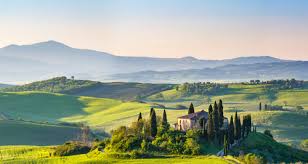Italy: The beautiful Mundane Landscapes in North

Rome: Screenwriter Ennio Flaiano once stated that “In Italy, the shortest distance between two points is the arabesque,” encapsulating in one sentence his compatriots’s talent for long-windedness, convolution, and elegance.
I’ve always thought Flaiano’s witty remark finds a perfect counterpart in the photographic work of Luigi Ghirri, who dedicated his career to depicting scenes from the country.
Born in 1943 in a small village in Emilia-Romagna, in northern Italy, Ghirri spent his working life in the same region which incidentally produced film directors Federico Fellini and Michelangelo Antonioni, two other paramount Italian storytellers. The country’s postwar climate, economic revival, and cultural ferment during the 1960s significantly influenced Ghirri’s development as an artist.
A hopelessly distracted man with perennially greasy glasses, Ghirri left his day job as a surveyor in the early 1970s to fully dedicate himself to photography. He liked to work in series, which often overlapped and led him to new projects: close-ups of pages from atlases, pictures taken during journeys by train, photographs of amusements parks, of the sky, of the studio of painter Giorgio Morandi.
Ghirri also loved Bob Dylan and greatly admired certain American photographers. He revered Walker Evans above anyone else, enjoyed the elusiveness of William Eggleston’s pictures, and appreciated the simple poetics of Paul Strand’s photographs. He would have certainly been aware of Strand’s photo-book Un Paese – Portrait of an Italian Village, published in 1955 as the outcome of the American photographer’s stay in Luzzara, a small village not too far from Ghirri’s own hometown.
Even though Ghirri exhibited extensively until his sudden death in 1992 — he was 49 when he was struck by a heart attack — the U.S. art world only took notice of his work relatively recently (the first book published on him in the States appeared in 2008).
Recently, MACK Books published Colazione sull’Erba, named after one of the earliest series shot by Ghirri at the beginning of the 1970s. Between 1972 and 1974, he roamed the outskirts of Modena, photographing balconies adorned by potted plants, small gardens, eccentrically pruned trees, and flowerbeds arranged in front of suburban condos and single-family houses.
The first forty pages of the book mirror the sequence and layout of a small catalogue published on the occasion of two exhibitions of Ghirri’s work, held in the mid 1970s. The remaining pages are part of a selection of images from Ghirri’s own archive, which he collated himself and never published.
Evoking the title of Édouard Manet’s painting “Le Déjeuner sur l’herbe” (1862-1863), Ghirri’s naming of the series (Italian for “Luncheon on the Grass”), hints at the photographer’s interest in the ambiguous relationship between nature and its interpretation. Ghirri’s cypresses, edges and other ornamental plants gesture to the forest in the background of Manet’s painting, which looks more like a backdrop than a real wood. “In this series of photographs, I sought to offer an existential portrait, as well as a series of references to the natural world, to home and its contemporary inhabitants” Ghirri wrote about the project in 1979.
Remarkably, the images in Colazione sull’Erba feature most of the elements that would later make Ghirri’s style of photography unmistakable. With few exceptions, subjects are estranged by their context, captured in isolation and placed at the center of the image. Ghirri’s framing is always frontal, an aspect which enhances the almost documentary feel of the series. The contrast between the geometric sterility of architectural elements, walls, and railings, and the more decorative arrangements of plant pots and flower boxes is a frequent motif.
Yet, the pictures retain a strong narrative element. Looking at the inexhaustible catalogue of fences, edges, and balustrades framed by Ghirri, one can’t help but wonder about the absent owners of these provincial houses. Who are they?
What do they do? And, above all: Where did they go? With the exception of little figurines, plaster cherubs, Snow-whites and dwarves guarding gates and balconies, all human shapes are completely absent from these photographs. Not that we need them. One takes immeasurable pleasure in lingering over the thought of the ghost-owners, inventing their characters and lives.
In Ghirri’s images, everything has its place: the brass-coloured, anodized aluminum doors, ; a pair of plant pots arranged on either side of an entrance in the same way one would adorn the altar of a church; the artificial symmetries of trees in a garden. Ghirri’s Luncheon on the Grass images a world made of placid emotion and mundane events, such as a Sunday family meal. As Ghirri would say, “The province is my place, my home.”





